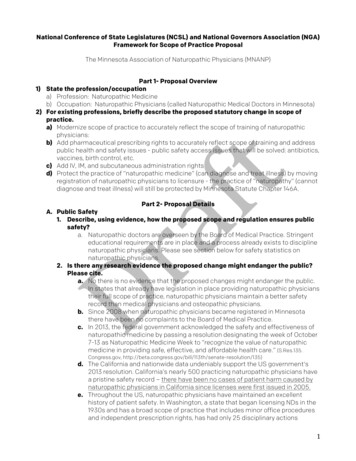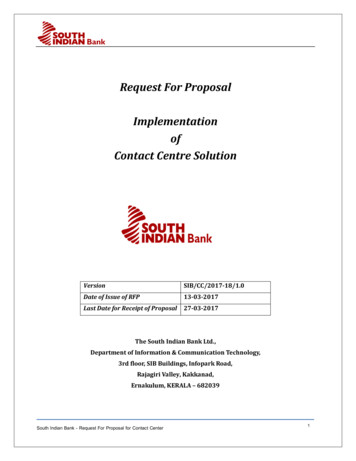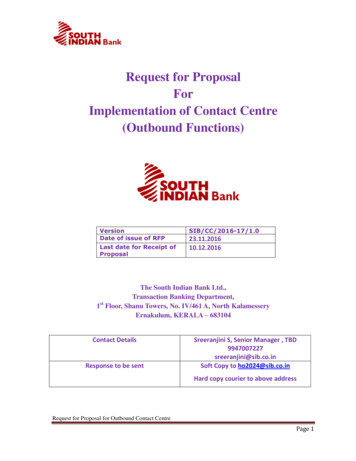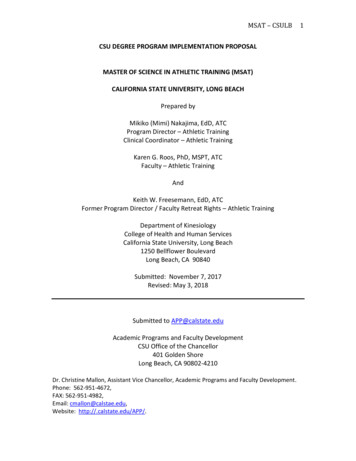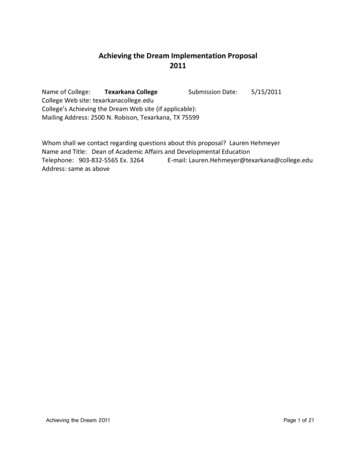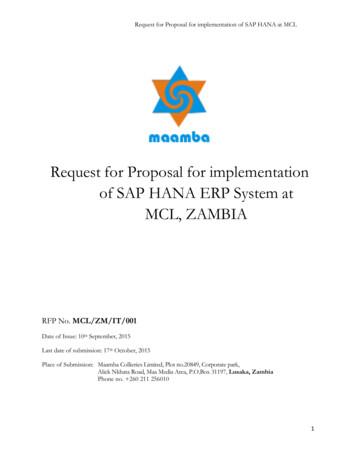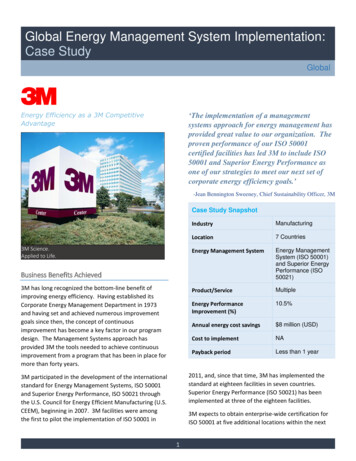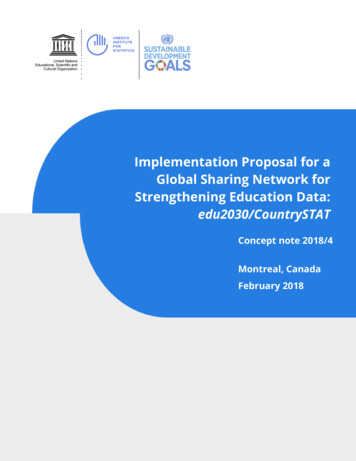
Transcription
Implementation Proposal for aGlobal Sharing Network forStrengthening Education Data:edu2030/CountrySTATConcept note 2018/4Montreal, CanadaFebruary 2018
2Implementation Proposal: A Global Sharing Network for Strengthening Education DataUNESCO Institute for StatisticsP.O. Box 6128, Succursale Centre-VilleMontreal, Quebec H3C 3J7 CanadaTel: 1 514-343-6880Email: rg
3Implementation Proposal: A Global Sharing Network for Strengthening Education DataSummaryThe proposal creates a Global Data-Sharing Network (edu2030/CountrySTAT) as a data exchange framework.Networks resources will be applications and tools made available for data aggregation, statistical analysesand dissemination to facilitate the acquisition, management, and analysis of large, diversified anddistributed sets of data. It supports multiple-sourced data integration and harmonisation according tointernational standards and contributes to improving data quality and reliability. It will serve as a platformto submit data to the UNESCO Institute for Statistics (UIS) and to validate indicators.The main objective is to improve the dissemination of education data with a special emphasis on SustainableDevelopment Goal 4 (SDG 4) data to monitor progress in education through: Adapting the CountrySTAT data exchange framework to education integrating existing systemand workflows at the country level. In a group of pilot countries in Africa, implementing the information system and institutionalframework to support data dissemination and archiving of educational data.Each country will be responsible of their own platform. The UIS will establish partnerships with statisticaloffices to introduce the system and build national capacity to disseminate internationally-comparable,official statistics.As value-added, the project builds country ownership, enables access to existing data through a single onlineaccess point, serves as a powerful instrument for strengthening decisionmaking based on facts, facilitatesthe exchange of data and metadata based on international standards, and enhances national capacity andstrengthens institutional processes while serving to monitor national, regional and global initiatives.The deliverables will include: the edu2030/CountrySTAT platform with a data exchange mechanism;improved data collection and validation;availability of key baseline data and indicators;improved SDG 4 data coverage; andpartnerships set into place.The duration of the project is about 36 months in six pilot countries, with a cost of approximatelyUS 6 million. Once piloted, the project could be scaled-up to all regions.
4Implementation Proposal: A Global Sharing Network for Strengthening Education Data1.Background and rationaleThe SDG on education (SDG 4) is putting strong emphasis on data generation and monitoring to manage theeducation sector more efficiently and effectively. The goal is very holistic and put forward the lifelonglearning approach which calls for progress in education for all age groups and at all the levels of education.This requires clear indicators and measurement to generate evidence-based international discourses andadvocacy. Moreover, SDG 4-Education 2030 is a universal and collective commitment of all countriesregardless of their level of development. Looking at the data requirements to monitor Education 2030, it isclear that various data sources need to be used and a “traditional approach to data may have reached theirlimits” (UIS, 2016a1).Global challenges in improving education require fast, informed and targeted decisions. In order to developpolices based on sound evidence, decisionmakers need information to respond to critical questions basedon high-quality, comparable and timely data.However, there is still a long way to go because more often than not countries face challenges such as: Lack of harmonisation between data and metadata;Poor data dissemination systems;Restrictive or unclear data and data use policies;Gaps between data produced and its availability;Unclear protocol on privacy and anonymity;Failure of systems that equally accept both highly-formal and less-formal submissions toprovide curated efforts to distinguish or warn about quality and reliability; andLack of a culture of using the data.To support improvement, the UIS has proposed the creation of a global network to share successfulexamples from other sectors such as agriculture. The platform edu2030/CountrySTAT aims to make highquality statistics widely available to support monitoring and measuring of education goals and specificallySDG 4.2.ObjectivesThe purpose of the project is to create a Global Data Sharing Network (in the spirit of the “Open Data”concept and approach). Network resources such as datasets, coding systems and classifications, text andready-made products (i.e. charts, maps and reports) are made accessible through their metadata.The platform edu2030/CountrySTAT is a web-based system for both national and sub-national levels thatsupports collection, analysis and dissemination of data, using adequate tools and international standards.UNESCO Institute for Statistics (UIS) ( 2016a). Sustainable Development Data Digest: Laying The FoundationTo Measure Sustainable Development Goal 4. Montreal: nabledevelopment-data-digest-2016-en.pdf1
5Implementation Proposal: A Global Sharing Network for Strengthening Education DataIt would support multiple sourced data integration and harmonisation based on international standards andcontribute to improve data quality and reliability.The edu2030/CountrySTAT database would embed the following levels of data: National core data: data that have been aggregated to the national level using methodology forinternational comparability. The data will be presented in a standard data structure set by the UISaccording to the hierarchies of its indicator system. Thematic modules: relevant national modules that are not included in the core but are very importantat the national level tailored to the country’s data needs. Global reporting and validation: key sets of indicators and metadata, including a reporting andvalidation platform.Figure 1. Flow between sources, concepts and dataDataPublishedUIS.StatData processingCollection throughUISquestionnaires willmigrate to CountrySTATAll data are organised byindicatorsEach sub-domain is defined by: Concepts, Definitionsand Classifications Coverage, Availabilityand Sources Process, Estimation andMethodology Other Reference InfoCensus and Surveys Overview Design Operation and QualityControl Statistical ReportAdministrative Records Responsible Agency Description of thecontained info Data SourcesCountry ACountry B
6Implementation Proposal: A Global Sharing Network for Strengthening Education DataSpecific objectives are to: Support and provide guidance in the creation of a database at the regional level which will combinestatistical data from all Member States; Assist Member States in data harmonisation and dissemination by providing technical assistance instatistics and facilitating collaboration, sharing and exchange of data; Ensure the archiving and dissemination of statistical data; Respond to requests for complex data from different areas related to education; and Enable data exchange among Member States and between Member States and the UIS.3.Activities and expected outputsThe main activities include setting institutional frameworks as well as equipment, training activities,translation, consultants and software preparations.The main outputs to be achieved are:Objective 1: CountrySTAT operational at the national level Output 1.1: Institutional Framework implemented which involves key government institutions of the6 countries as recognised by the African union Output 1.2: Operational capacities implemented and strengthened in 6 African union countries Output 1.3: National CountrySTAT system implemented and rolled out in 6 African union countries Output 1.4.: Technical capacity of national staff is strengthened.Objective 2: The UIS and AU increasingly provide support to Member States and technical support tocountries is increasingly provided Output 2.1: Institutional Framework and operational capacities implemented and strengthened in theregional and global Secretariat Output 2.2: Data harmonisation mechanisms in place and agreed among all the stakeholders Output 2.3: Communication channels in place.4.Structure and implementation strategyThe structure is flexible and allows to add/remove modules and/or to prioritise activities without losingconsistency in the overall project framework. The proposed structure considers that there are followingmodules that contribute to build the global data-sharing network:i.Institutional capacity building at national and regional levels, which implies supporting existingnational and regional institutional frameworks;ii.Strengthening of statistical methodologies and data collection/processing support;iii.Information technology support to countries and regions to facilitate data storage, harmonisation,processing, exchange and dissemination; increase efficiency of the I.T. platform for data analysisand sharing; and
7Implementation Proposal: A Global Sharing Network for Strengthening Education Dataiv.Implementation of a multi-disciplinary communication strategy to maintain the CountrySTAT usercommunity, share knowledge and promote the system worldwide.Most of the success of the project depends on the level of integration between these four modulesas essential elements of the global data-sharing network. It is nearly impossible to build a sustainable datamanagement and sharing system without strong support and commitment of the agencies involved. Thenetwork requires people contributing to the maintenance and evolution of the system by providingrequirements, feedback, expertise and technical and promotional work. A sound and constructiveinteraction between decisionmakers, technicians, analysts and I.T. developers will create the necessaryenvironment to make the network useful and productive.The statistical methodological approach of CountrySTAT will be sustained by the UIS as part of its mandateand will be shared with countries.The UIS will make CountrySTAT operational in six African countries. The UIS proposes to implementCountrySTAT in the countries where:1. The Commission's Directorate-General for International Cooperation and Development (DG-DEVCO)provides development policy assistance;2. FAO has implemented the data framework in agriculture; and also preferably where3. The UIS has implemented the CapED Pilot Programme.This ensures a consistent approach with and a complementary role to DG-DEVCO, it allows us to start withcountries which have national statisticians (albeit in a different field) already familiar with web-basedinformation systems and enhancing the data-sharing experience. In addition, the implementation ofCountrySTAT serves the aim of the CapED programme which is to develop national capacities in participatingcountries to integrate SDG 4 commitments into national education policy and sector management, includingmonitoring of progress towards SDG 4.For this reason, the UIS proposes to implement CountrySTAT in Ethiopia, Ghana, Madagascar, Mali,Mozambique and Senegal.5.Institutional FrameworkThe Secretariat will be the UIS and it is foreseen to have a regional counterpart institution for the project. InAfrica we expect the African Union (AU) to play this role. AU staff will work closely with the UIS team, as wellas other partners involved in the project, on the overall coordination and smooth implementation of theplanned activities.In each of the six countries, there will be one key contact responsible to ensure the implementation ofCountrySTAT, its proper coordination and support throughout the life of the project. They will benefit from theadvice of UIS staff and specialised consultants to facilitate the implementation of the activities.
8Implementation Proposal: A Global Sharing Network for Strengthening Education Data6.Value addededu2030/CountrySTAT will:a.Reduce the burden of completing questionnaires by facilitating electronic data collection;b. Reinforce national statistical capacities by providing methodology, classification and coding systems tosupport the collection, standardisation and harmonisation of data from various local sources;c.Promote partnerships between the main statistical institutions providing data within countries;d. Assist countries in integrating and organizing national data in order to make them comparable at theinternational level; ande.7.Help countries disseminate data through communication and information tools at national andsubnational levels.Timeline and budgetProject timeline: 36 months starting as soon as funding is available.The total project cost for the implementation and development of the platform in six pilot countries includefunding for regional coordination and the UIS as coordinating agency. The key components of the budgetare: country and UIS Headquarters activities, training and technical assistance;design-based thinking and rapid prototyping workshops to define user needs;Equipment (expendable and non-expendable);Translation;Regional and international staff/consultants; andAdministrative support and general operating expenses and supplies.Budget of the project (USD)Country 1500,000Country 2500,000Country 3500,000Country 4500,000Country 5Country 6500,000CountrySTAT platformUIS SecretariatTotal500,0001,500,0001,000,0005,500,000
The proposal creates a Global Data-Sharing Network (edu2030/CountrySTAT) as a data exchange framework. Networks resources will be applications and tools made available for data aggregation, statistical analyses and dissemination to facilitate the acquisition, management, and analysis of large, diversified and distributed sets of data. It supports multiple-sourced data integration and .
